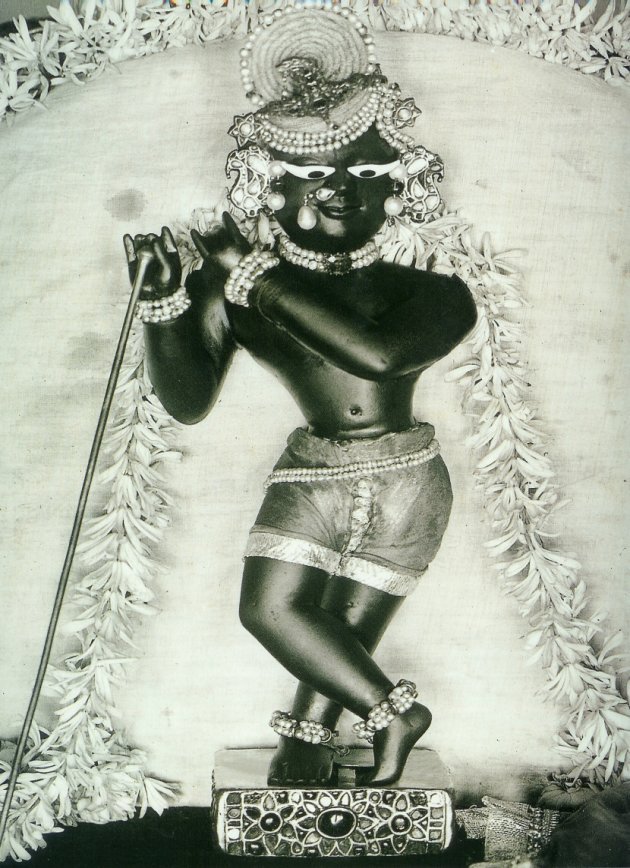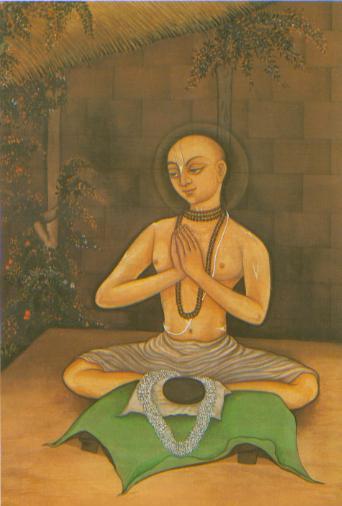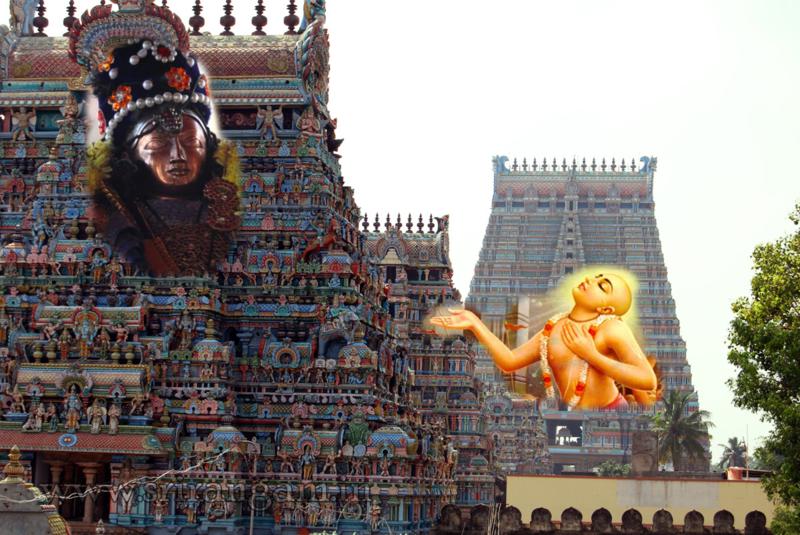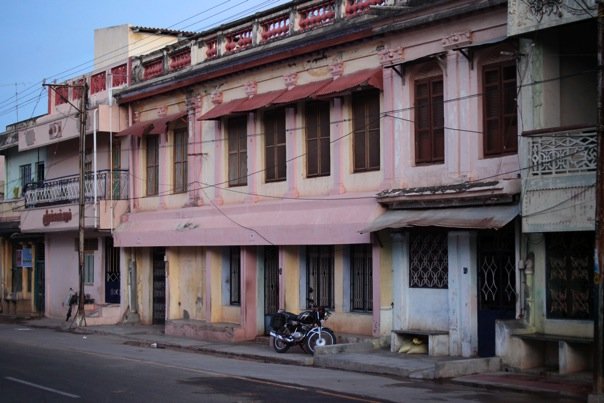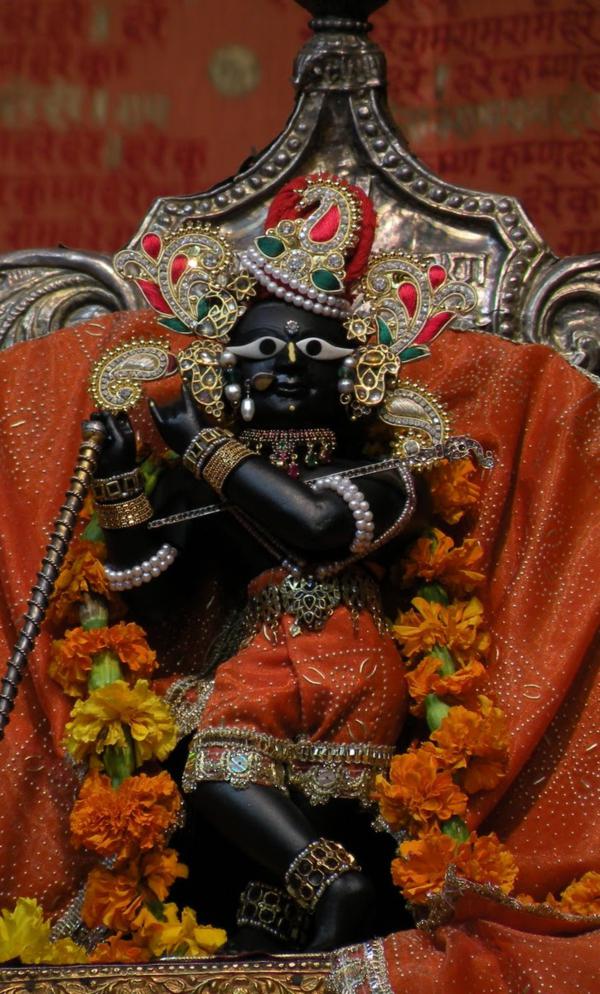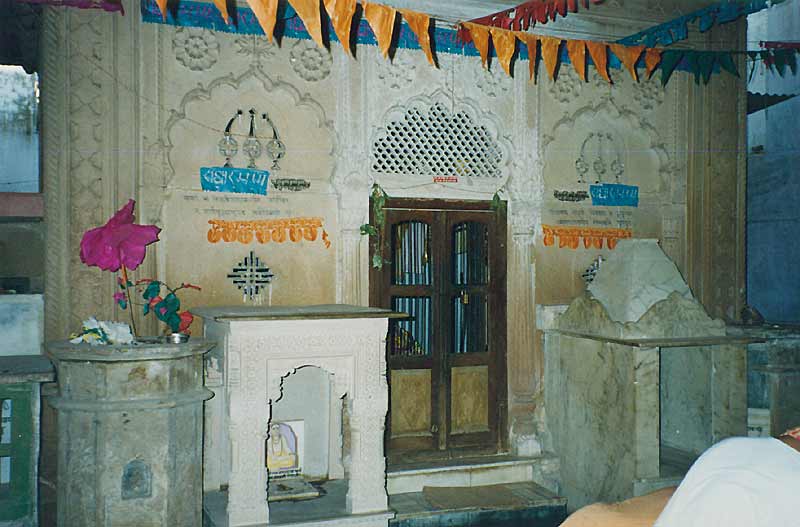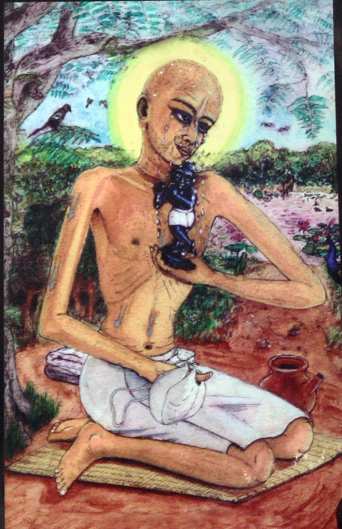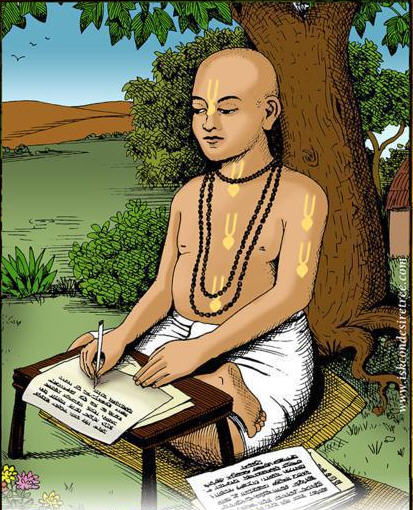
Shrila Gopala Bhatta Goswami.
Shri Gopal Bhatt Goswami, one of the six Goswamis of Vrindavan, was born in 1503 on the 13th day of the dark moon in the month of Pausha. Shrila Gopal Bhatt Goswami lived for 75 years and left this world to enter into the eternal pastimes of the Lord in 1578.
Shri Gopal Bhatt Goswami was the son of Vyenkatta Bhatt, a brahmana resident of Shri Rangam in South India, who was initiated in the Shri Sampradaya tradition, in the disciplic succession of Shri Ramanujacharya.
Shri Vyenkatta Bhatt’s had a famous brother named Shri Prabodhananda Saraswati. The son of Vyenkatta Bhatt was later known in the Gaudiya Sampradaya as Gopal Bhatt Goswami and he established the Radha-Ramana Temple in Vrindavan.
During his travels in southern India, Chaitanya Mahaprabhu came to the famed Shri Rangakshetra which has the famous Temple dedicated to Lord Vishnu as Shri Ranganath. When Shri Gauranga Mahaprabhu entered the Temple and began chanting Hare Krishna kirtan, He mesmerized the Devotees in the Temple.
Everyone was stunned in ecstasy and the hairs of their body stood on end. Mahaprabhu’s divine form was wonderful to behold, and his bodily radiance was dazzling. From His lotus eyes showered torrents of tears of Krishna-prema. The brahmanas wondered, "Is he a god? Is such a manifestation of ecstasy possible in a man?"
Again and again exhorting everyone to chant the Holy Name, saying, "Haribol! Haribol!" Mahaprabhu fell before the Deities like a tree that has been cut down.
Shri Vyenkatta Bhatt, detecting in Shri Chaitanya Mahaprabhu the signs of a Mahapurush could not contain himself as he saw the Lord performing sankirtan. Pushing his way through the crowd, he joined the kirtan party and lost himself in dancing and singing the Holy Name of Hari with the Lord.

Shri Rangannatha Swami Temple, Shrirangam.
When the Lord regained His external consciousness somewhat and had steadied Himself, Vyenkatta fell in the dust of His lotus feet and asked the Lord for His mercy. The Lord lifted him into His embrace saying, "Krishna! Krishna!" At that time, Shri Vyenkatta invited the Lord to stay with him in his home during the four months of the rainy season.
In this way, the Lord passed His days in great happiness, enjoying the transcendental mellow of discussing Lord Krishna's pastimes with Shri Vyenkatta Bhatt.
In 1511, Shri Chaitanya Mahaprabhu stayed at the house of Vyenkatta Bhatt. Vyenkatta had a son named Gopal. At the time of Mahaprabhu's visit, he was only a child. When the little boy offered his respects at the feet of Shri Chaitanya, the Lord picked him up and held him on His lap and affectionately embraced the boy. Shri Chaitanya Mahaprabhu used to call the child and give him the remnants of His Prasad. By giving him His Prasad in this manner, He blessed Gopal Bhatt Acharya to become a great Devotee in the future.
Every day, Shri Gopal Bhatt would serve Him personally. At that time, Shri Chaitanya instructed Vyenkatta Bhatt on the esoteric truths regarding the position of Shri Lakshmidevi and the worship of Lakshmi-Narayana versus the position of the gopis and the worship of Shri Radha-Govinda.
The Lord preached these points to him in a humourous style, laughing and joking in a clever way. The Lord said, "Bhatt! Your Lakshmidevi is the crest jewel of chaste ladies. My Krishna is a gopa-boy who herds cows. Why does she want to be with Krishna?"
Vyenkatta Bhatt said, "Krishna and Narayana are one and the same. Krishna is one of the forms our Lord takes in order to enjoy pastimes of a sweet and sporting nature. There is no violation of Lakshmidevi's chastity if she takes an interest in Krishna – he is one and the same with Shriman Narayana. There is no contradiction with any religious principles.”
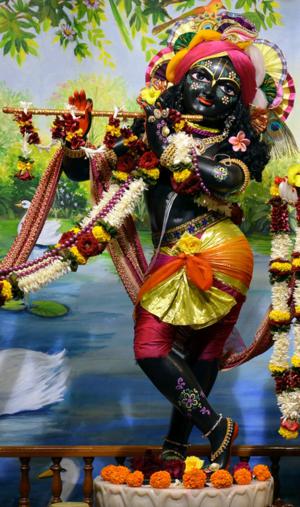
"Krishna and Narayana are one and the same. Krishna is one of the forms our Lord takes in order to enjoy pastimes of a sweet and sporting nature. There is no violation of Lakshmidevi's chastity if she takes an interest in Krishna - he is one and the same with Shriman Narayana. There is no contradiction with any religious principles.” (In the image: Shri Madan Gopal, ISKCON Nashik, Maharashtra).
The Lord said, "What you say is true. But tell me, why is it that Lakshmidevi performs great penance to attain Krishna, but cannot do so? On the other hand, the Upanishads also performed penances to attain Krishna and did so. How is it that the Upanishads succeeded in entering Vrindavan and getting Krishna's association where Lakshmidevi failed?"
Vyenkatta had no answer. Then Lord Chaitanya explained that Lakshmidevi wanted to retain her opulent position as Goddess of Fortune in Vaikuntha while at the same time enter into the pastimes of Krishna, where sweetness and beauty are superior to power and opulence.
This is not possible. Only those who follow in the footsteps of the gopis and the residents of Vrindavan can attain such a position. The Upanishads succeeded where Lakshmidevi failed because they followed in the footsteps of the gopis.
Before this explanation was given Vyenkatta Bhatt believed that Shri Narayana was the Supreme Personality of Godhead. Thinking in this way, he believed that the worship of Narayana was the supreme form of worship. Mahaprabhu understood his misconception and gently corrected it by making good-natured jokes about it.
After this, Vyenkatta was convinced of the supreme position of Shri Krishna and Vrindavan, and converted to the cause of Gaudiya Vaishnavism, although he was raised in the Ramanuja Sampradaya. He offered his respects at the lotus feet of the Lord and the Lord embraced him.
In this way, the Lord spent the four months of the rainy season at the home of Vyenkatta, discussing many things about Krishna and His pastimes. After this, he bid farewell. Gopal Bhatta fainted at the Lord's lotus feet. The Lord comforted little Gopal saying, "Now you must serve at the home of your mother and father. Later, you will come to Vrindavan. There you will constantly hear and glorify the Holy Name of Shri Krishna." In this way, after instructing the whole family, Shri Chaitanya Mahaprabhu went on his way.
Within a short time, Shri Gopal Bhatta Goswami learned Sanskrit grammar, poetry, rhetoric and became expert in all the scriptures, beginning with the Vedanta sutra. His uncle, Shripad Prabodhananda Saraswati instructed him extensively in the different bhakti-shastras.
After he had been blessed by having darshan of the lotus feet of Shri Gauranga, Gopal Bhatta Goswami's mind was always absorbed in thoughts of the Lord's lotus feet. He began thinking, "When will I again obtain a vision of the Lord?"
In this way, the years passed. Eventually his aged mother and father called Gopal Bhatta to their side and said, "Boy, after we pass away, you must go to Vrindavan and take shelter of the lotus feet of Shri Chaitanya Mahaprabhu." After his parents’ demise, Gopal Bhatta went to Vrindvan, always remembering the lotus feet of Mahaprabhu.
When Gopal Bhatta arrived in Vrindavan, he found that Shrila Rupa Goswami was preparing to send messages with some Devotees from Vrindavan to Shri Chaitanya Mahaprabhu in Puri. Shri Rupa and Shri Sanatana Goswamis already knew that Gopal Bhatt would be coming to Vrindavan. Shri Rupa and Sanatana greeted him and treated him like a brother. From that time on, their lifelong friendship began.
When the messengers arrived in Puri, Mahaprabhu was happy to hear that Gopal Bhatt had gone to Vrindavan. He sent the messenger back to Rupa Goswami with his kaupin and outer garments of the babaji order, to be given to Shri Gopal Bhatta Goswami as symbols of his renunciation.
Shri Rupa received these things with great joy. Shri Gopal Bhatta Goswami accepted the loincloth and dress of a sanyasi with great happiness, considering it to the Lord's mercy and Prasad. In this way he would pass his nights at different kundas, and spent all his time studying the shastra and writing.
After some time, Shri Gopal Bhatta Goswami went on a pilgrimage to various holy places. He halted in a town called Devavandya Gram in Saharanpur near Hardwar. There he was received with great delight by the residents. One day, he was on his way to the house of a Devotee near the edge of the town.
In the afternoon, there was a great storm. Gopal Bhatta took shelter in the house of a brahmana who was a great Devotee of Lord Krishna. He saw to the needs of Shri Bhatta Goswami with great care. Shripad Gopal Bhatta Goswami was very happy. The brahmana had no son. Gopal Bhatta blessed him, saying, "May you have a son who is a great Devotee of Krishna." The brahmana then said, "I shall give you my first son to engage in the service of Krishna as you see fit."
After spending some time in Hardwar, he went further north into Nepal and to the Gandaki river where he retrieved twelve Shalagram Shilas from the river.
Shri Gopal Bhatta Goswami had twelve Shalagram Shilas. He used to keep them in a cloth bag hung round his neck. Still, he had a desire to worship the Shri Vigraha of the Lord in his Deity form. Around this time a rich merchant visited Shri Gopal Bhatt Goswami. Eager to serve, the rich man offered some fine clothes and ornaments for the service of the Lord. Shri Gopal Bhatta placed these things before his Shalagrams saying tearfully that he wished he could adorn the Lord with all the nice ornaments and clothes.
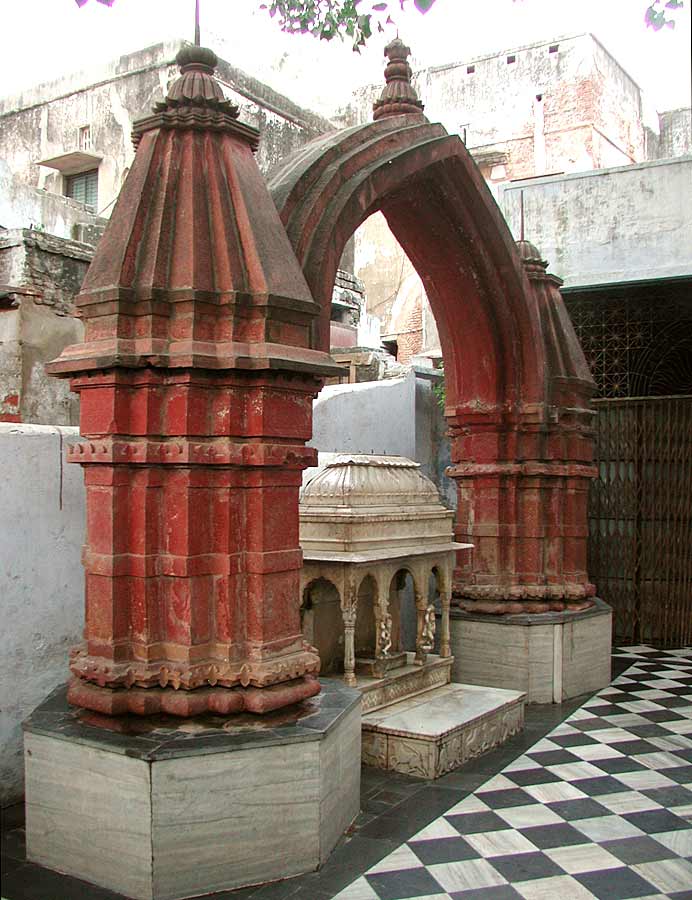
The place where Damodar Shaligram Shila took the form of Radha Raman, Shri Vrindavan Dham.
That night, Shri Bhatta Goswami offered arati and bhoga and put his Shalagrams to rest, covering them carefully in a basket and hanging the basket on the branch of the tree under which he lived. Then after performing his bhajan, he took some Prasad and went to sleep. The next morning he bathed in the Yamuna as usual and went to wake his Shalagrams. When he opened the basket, he saw, in the midst of the Shalagrams, one of the Shalagram shilas had turned a full-fledged Deity of Krishna in a charming three-fold bending posture, who stood there looking exquisitely beautiful.
Seeing the unprecedented beauty of this Deity, Gopal Bhatt dived in an ocean of joy. Shedding tears and offering his full dandavats to the Deity, he began spontaneously offering hymns and prayers to the Lord.
Hearing of the miracle, Shri Rupa and Sanatana Goswamis, as well as the other Vaishnavas and Goswamis quickly went and saw the world-enchanting beauty of the Deity as tears of divine love flowed from their eyes. In the year 1599 on the full moon day of Vaishakha, this sweet Deity of Krishna became manifest. The Goswamis named this Deity, "Shri Radharamana deva."
Almost ten years later one day, Shri Gopal Bhatta Goswami went to take his noon bath in the Yamuna and returned to his kutir to perform his bhajan. From a distance he saw a young boy sitting at the door of his hut.
When the boy saw Shri Bhatta Goswami he arose and offered his obeisances at the Goswami's feet. Shri Gopal Bhatta asked him, "Who are you?" The boy said, "I am from Devavandya Gram in Saharanpur. I have come from there."
Bhatta Goswami said, "Who is your father? Why have you come to me?" The boy said, "My father has sent me here to engage in your service. My name is Gopinatha." Gopal Bhatta then remembered the boy's father in Saharanpur, in which the brahmana said he would give the Goswami his son to engage in the service of the Lord. After this time, Shri Gopinatha served Shri Bhatta Goswami with great attention.
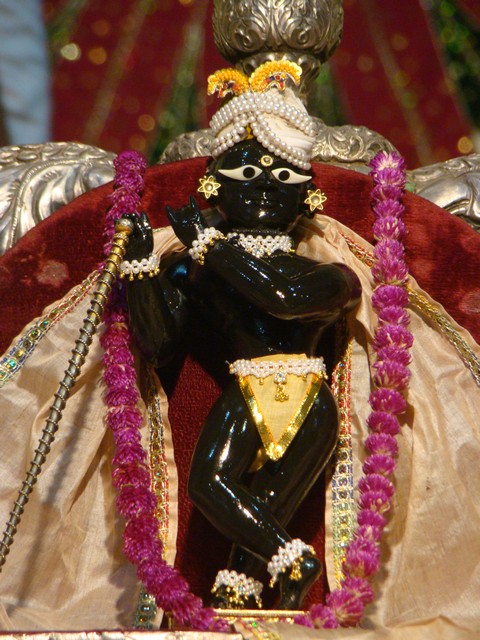
Hearing of the miracle, Shri Rupa and Sanatana Goswamis, as well as the other Vaishnavas and Goswamis quickly went and saw the world-enchanting beauty of the Deity as tears of divine love flowed from their eyes. In the year 1599 on the full moon day of Vaishakha, this sweet Deity of Krishna became manifest. The Goswamis named this Deity, "Shri Radharamana deva." (In the image: Shri Radharaman, Shri Vrindavan Dham).
Subsequently that boy became known as Shri Gopinatha Pujari Goswami. He remained a brahmachari and served the Radharamana Deity up until his death.
Shri Gopal Bhatta Goswami served his beloved Radharamana Deity lovingly, remembering the words and teachings of Shri Chaitanya Mahaprabhu. While serving in this way, the eyes of Gopal Bhatta would often filled with tears of divine love that flowed like gushing streams.
Where upon Shri Radharamana bestowed upon Shri Bhatta Goswami a divine vision of Shri Gauranga Himself. The Bhakti Ratnakara 4th Taranga says, "When Shri Bhatta Goswami was overwhelmed by Krishna-prema, Shri Radharamana revealed Himself as Shri Gauranga deva."
Shri Gopal Bhatta Goswami accepted Shrinivasa Acharya as his disciple. Shrila Sanatana Goswami composed Hari Bhakti Vilasa in collaboration with Gopal Bhatta Goswami, who edited the work. Sanatana Goswami had such great affection for Gopal Bhatta Goswami that he even published the book under his name.
Shri Gopal Bhatta Goswami was responsible for originating the six thesis of Sat Sandarbha later elaborately developed by Shri Jiva Goswami.
Jiva Goswami writes in the beginning of his Tattva-Sandarbha: "A Devotee from South India who was born of a brahmana family and was a very intimate friend of Rupa Goswami and Sanatana Goswami has written a book that he has not compiled systematically. Therefore I, a tiny living entity called Jiva, am trying to assort the events of the book systematically, consulting the direction of great personalities like Madhva, Shridhara Swami and Ramanujacharya."
Gopal Bhatta Goswami has written a foreword to Jiva Goswami's Sat Sandarbha. He wrote a commentary on Krishna-Karnamrita. He also wrote Sat-Kriya-Sara Dipika, a guide to Vaishnava samskaras and rituals for birth ceremonies, sacred thread initiations, marriage ceremonies, sannyasa, and funerals etc. In addition to this he composed many other scriptures.
In the Gaura-Gandodesha-Dipika, Shri Kavi Karnapura Goswami writes:
ananga-manjari sadya Gopal Bhattkah
Bhatt goswaminam kocidahuh shri guna manjari
"In my opinion, that person who in Vrindavan Leela was Ananga Manjari is now Gopal Bhatt Goswami. Some authorities, however, have given their opinion that he was Guna Manjari."
http://www.srigaurangashram.in
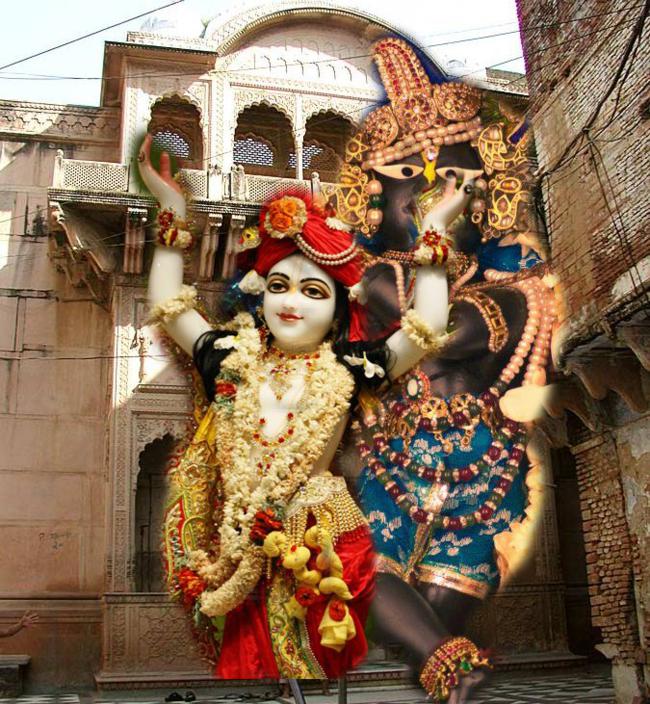
Where upon Shri Radharamana bestowed upon Shri Bhatta Goswami a divine vision of Shri Gauranga Himself. The Bhakti Ratnakara 4th Taranga says, "When Shri Bhatta Goswami was overwhelmed by Krishna-prema, Shri Radharamana revealed Himself as Shri Gauranga deva." (In the image: Shri Radha Raman, Lord Chaitanya in ISKCON Chennai Temple, and behind there is Shri Radha Raman Temple, Shri Vrindavan Dham).

